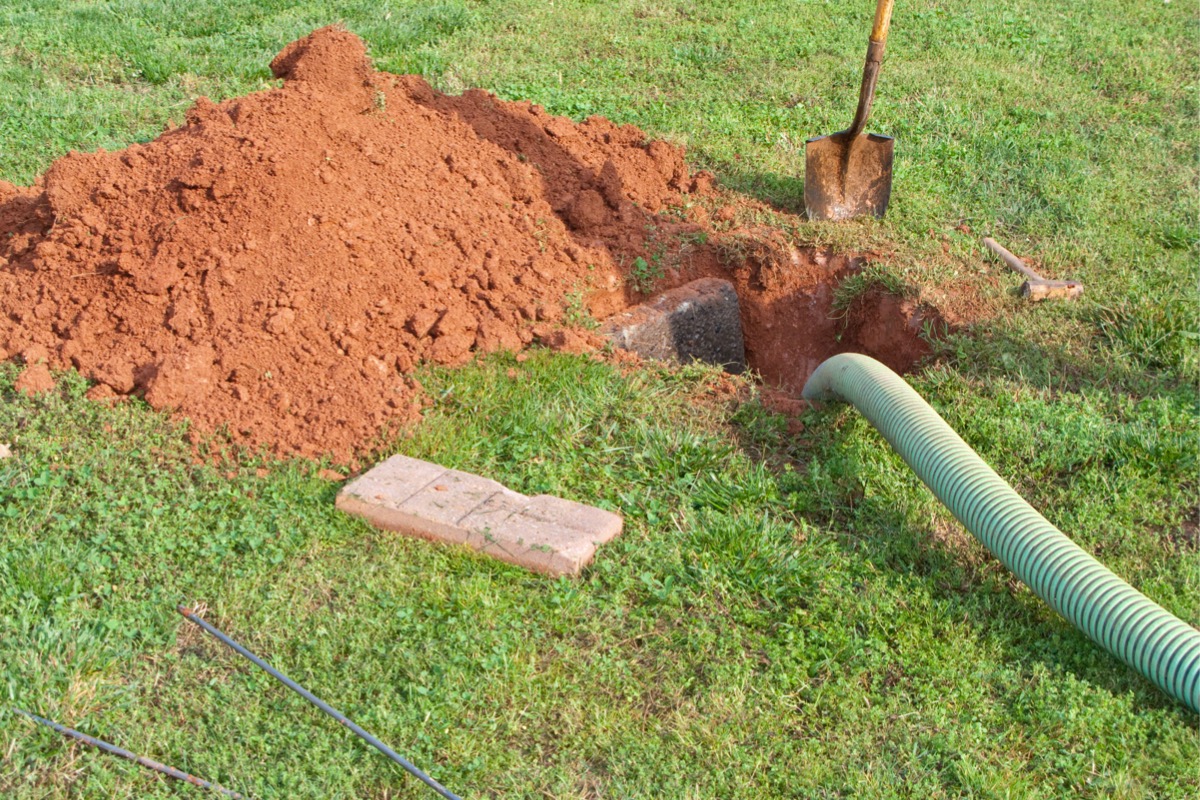

We may earn revenue from the products available on this page and participate in affiliate programs. Learn More ›
A septic tank should be pumped regularly, or else it can cause your home’s entire wastewater system to back up. However, the septic tank can be difficult to spot if you don’t know where it was installed. This is a common occurrence for new homeowners, so it’s important to learn how to find out where your septic tank is buried and repair leaks or flooding before they become more expensive problems.
It’s also important to understand where the tank and the septic drainfield is located before digging or trenching for any landscape or building project, to avoid damaging any of the leach lines.
If it’s at all possible at the time of purchase, it’s a good idea to ask your home’s previous owner where the septic tank is before finalizing the sale. The previous owner should be able to provide the exact or an approximate location of the lid. Though, even if you don’t know the approximate location of your septic tank, this guide will introduce you to methods you can use to figure out how to find your septic tank.
Before You Begin
Scoping out your septic tank by walking around the yard or making calls to the county clerk is relatively easy to manage for most homeowners. If you get to the point at which you drive a soil probe into the ground, or dig up the yard with a shovel, proceed very carefully or call a professional. You run the risk of damaging wire, pipes, and other home infrastructure.
Similarly, attempting to excavate the septic tank, remove the lid, or otherwise access the septic tank are not actions we recommend. Septic tanks contain wastewater and gasses that can be harmful, so it’s best to call in the pros for cleaning and maintenance services after finding the septic tank lid.
Tips for Locating Your Septic Tank
Consult local county records for your home’s septic system permit.

A septic tank’s location can impact nearby water sources, so installers commonly must apply for septic system permits to mitigate the risk of environmental damage or drinking water contamination. Thanks to this practice, your local county should have a record of where your septic tank is buried.
If this record was provided with the purchase of your home, you can review the septic system diagram to determine the size of your tank and the number of lids it has to help narrow down its location. Some older homes may not have these records, however.
Inspect your yard for signs of the septic tank.

One of the easiest ways to locate a septic tank is to simply go for a walk around your house. Septic tanks can commonly be spotted by looking for signs of a large buried object in your yard. A probable indicator would be a large divot or hill, which often occurs when the initial hole dug for a septic tank is too large or small, respectively.
Also look for parts of the lawn that are patchy and difficult to grow grass or plants on. If there isn’t a significant amount of dirt covering the tank, then it’s likely that the area will have very sparse plant growth. Should these methods fail, the odor from an untreated septic tank will gradually build until you might narrow down its location by smell.
There are a few spots where you don’t need to search. Typically, a septic tank won’t be installed under or near a well water system, and they’re rarely buried under paved surfaces, like patios, sidewalks, or driveways. You can also rule out areas close to any major landscaping or yard features, such as a pool.
Follow the main sewer line from your home to your septic tank.
Septic tanks are connected to the main sewer line or waste pipe of a home, so you can follow the direction of this pipe to help pinpoint where your tank is buried.
Look through the basement, cellar, or crawl space to find the main sewer line running into your home. This pipe will generally be about 4 inches in diameter and made out of cast iron or heavy PVC pipe. When you locate the pipe, note the spot where it exits your home. Find the corresponding area outside and walk directly away from the house. Drain pipes are usually laid in straight lines, so you can be confident that the septic tank is buried somewhere along where the main waste pipe exits the home.
Follow the estimated path of the drain line and look for any signs that a septic tank has been buried in the area. A probe can help verify that you have found the tank’s location, and it’s also a good idea to use a shovel to uncover the lid. Mark the location with a lawn ornament, a small sign, spray paint, or measure the distance from the two closest corners of the home and keep a record of this information somewhere safe so you can refer to it in the future.
Use a soil probe to scope out the septic tank lid.

Septic tanks have one or two lids, depending on whether they have a single compartment or dual compartments for filtering and breaking down wastewater material. These lids tend to stick up from the main tank, so they can often be found with a soil probe (which makes for a highly effective septic tank locator tool). You can alternatively use a piece of rebar or any long, narrow object that’s hard enough to break the soil without much effort. Regardless of what you use, your probe should ideally be at least 4 feet in length. Make sure to not drive the probe too hard into the ground while probing; otherwise, you could damage the plastic septic tank lid.
Though, how deep is a septic tank? Septic tank installers don’t bury every tank at the same depth, so your septic tank may be buried as little as a foot underground or it could be covered in more than 4 feet of soil. You’ll want to use a hammer to help drive your probe down into the soil to find a deeply buried tank. A metal detector can also be used to locate septic tanks, and it may even detect the metal handles of septic tank lids to narrow down your probing.
When you locate your tank, mark the location with a lawn ornament or a small sign, or measure the distance from the two near corners of your home and keep a record of this information for future reference.
Check with local septic maintenance companies.

The cost of a new septic tank is enough that it’s worthwhile to invest in tank cleaning and maintenance, instead of needing to upgrade the entire tank due to poor care and misuse. If your local government doesn’t have records of your septic tank, then it’s possible that it was installed without a permit or is an older system predating permit requirements.
Either way, any septic system would have needed to be pumped at least once every three to five years to stay in good working order. With this in mind, you could contact local plumbing companies that offer septic maintenance services to see if the tank was previously pumped by them and if they know the tank’s location.

Trtied-and-True Advice
“About a year after my father passed away, bequeathing me the family home, plumbing problems reminded me that I had never asked Dad where the septic tank was located. My brother and brother-in-law had to tear up part of the backyard with a backhoe in an unsuccessful attempt to find it. Only after consulting a professional did we discover that the tank was much closer to the building than we had guessed, because an addition had been added to the back of that building after the tank was already in place. The lesson here is to ask your elderly relatives about where everything is located while you still have the opportunity to do so!”
—Audrey Stallsmith, Contributing Writer
Ask your neighbors.
How long a septic tank lasts depends on the level of care and maintenance, as well as several other factors. Depending on the age of the septic tank, there is a chance that it was installed at the same time as your neighbor’s tank, and may even be buried in a similar location, so you may be able to locate your septic tank simply by asking them.
Even if neighboring system systems weren’t laid in the same spots in relation to their houses, your neighbors may still have information about where your septic tank is located. Contact the neighbors who have lived in the neighborhood the longest. It’s feasible they could have seen your septic tank being serviced at some point in the last five years, in which case they may be able to point you in the right direction.
Enlist the help of a septic professional.

If you run out of DIY options and still haven’t found your septic tank, hire a professional to locate your tank to ensure it doesn’t go unmaintained for too long. The pros have the experience and resources to track down the septic system location using public records, the history of the house, and a variety of tools designed to locate septic systems.
While this method can save a lot of time, it does come with an added cost. With this in mind, before hiring the pros to locate a septic tank, it’s worth asking how much to locate a septic tank, as well as asking for an upfront estimate to ensure you know what’s included on the final bill.
FAQs
When learning how to find a buried septic tank, it’s necessary to consider how deep the tank lid may be buried under the ground. Typically, a septic tank lid can be buried anywhere from four inches to four feet underground, though the average depth is about one foot.
Generally, it’s a good idea to clean the septic tank about once every three to five years, depending on the number of people in the home, the size of the tank, and the frequency with which the home is occupied. For instance, vacation homes that are only occupied for a couple months each year, won’t require cleaning as frequently as a primary property that is lived in 24/7 all year round.
After figuring out how to locate your septic tank, you may feel confident enough to try cleaning the tank yourself. However, this isn’t recommended due to the need for specialized equipment, like a septic pump and tanker truck. Instead, homeowners can use one of the best septic tank treatments to help maintain the septic system until you can hire a professional to clean the tank.
Ongoing maintenance for a septic tank will typically cost between $100 to $1,000, depending on the size and condition of the tank, as well as the frequency of use. The cost to clean a septic tank ranges from $400 to $1,000.
